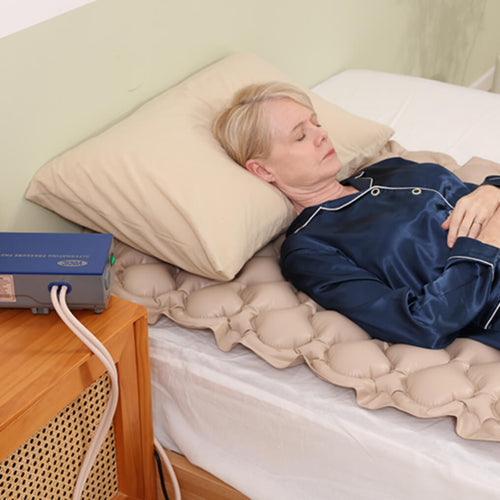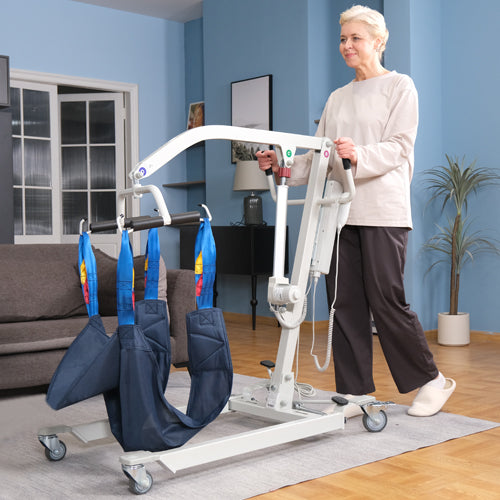One of the most crucial skills a caregiver and a healthcare professional should have is learning how to transfer a patient from bed to wheelchair safely. Safe transfer is also vital in ensuring that the patients are comfortable, not injured, and enabling the caregivers to work without having to strain.
At home or in a care facility, all the little details of knowing each step and applying the correct equipment, like a hoyer lift, make the difference in an easy and safe transfer.
Why Proper Patient Transfer Matters
The issue of proper patient transfer methods is very important as it directly affects the concept of safety and dignity. Lifting techniques may result in back injury, joint stress, or even the fall of patients. In the case of caregivers, chronic pain or muscle damage could occur due to inappropriate lifting repeatedly.
Inappropriate techniques can result in discomfort, fear, and a loss of trust for the patients. When the caregivers understand how to transfer a patient from bed to wheelchair safely, they will increase the patient's autonomy and self-esteem. This will ensure reduced cases of accidents and will improve the overall quality of services.
Necessary Equipment for a Safe Transfer
The presence of proper equipment may make a big difference in the security and effectiveness of patient transfers. High-quality wheelchairs and patient lifts minimize the amount of manual labor involved and make the whole procedure more comfortable for all parties.
Assess the Patient and Select the Appropriate Transfer Device
Determine the mobility, balance, and weight of the patient before trying to transfer him/her. This dictates the best transfer device to apply in a situation.
The VOCIC AY06 Electric Patient Lift - Wheelchair To Car Transfer Device is a perfect choice in terms of multi-use. designed for home and car transfers, it has smooth and powered lifting and does not require manual effort. Its smart electric motor provides the ability to operate silently and move in a controlled manner, making transfers comfortable for the patient.
The AY06 is very small and can be folded to be easily transported and stored. The robust steel frame ensures that it will not be destroyed easily. It is a perfect lift when the caregivers require a solid, convenient way of transferring at various locations: bed to wheelchair, wheelchair to sofa or even wheelchair to car.

To patients who still have some capacity to stand but require help in standing, the VOCIC AY03 Upgrade Sit to Stand Lift - One-Step Stand Assist Lift for Elderly provides the ideal balance between support and autonomy. The lift raises the patient on a single and easy-to-operate control to a standing posture. The wide foot platform and padded knee support make movement comfortable and safe.
The AY03 is particularly useful for elderly patients who require some assistance in the process of sitting to standing. It encourages participation and involves the user in using his or her muscles and keeps the person moving.
In case the patient is totally dependent and unable to support him/herself, the VOCIC AY02 Electric Full Body Hoyer Lift offers full body support. This medium lift is of professional grade and is used with patients who need complete assistance during transfer. The AY02 has a robust electric motor, a sturdy sling, which holds the patient firmly, and adjustable legs that fit most beds or chairs. Its hydraulic up and down movement reduces shaking and pain, which makes the experience of the patient dignified and the process of caregiving hassle-free.
The VOCIC lift models are adapted to various levels of mobility since the AY06 has a versatile multi-point transfer, the AY03 has partial standing support, and the AY02 has full support, providing caregivers with the appropriate tool to apply in each situation.
Preparing the Wheelchair for Transfer
It is necessary to prepare the wheelchair before starting a transfer.
Begin by putting the wheelchair near the bed preferably at a 45 degrees angle to the stronger side of the patient. Brakes should be locked to hold the chair in place and footrests or armrests should be removed.
Provided that you use a powered mobility aide, the VOCIC V62 Foldable Dual-batteries Power Wheelchair is a great option. The chair has high-quality comfort, strength and performance. Its two batteries offer a long distance and hence the patients can cover a very long distance without having to recharge their batteries frequently. It is easily foldable and easily portable due to the lightweight aluminum frame and has a sophisticated motor system that makes it operate smoothly and stably.
In the case of transfers, the V62 can be placed without any danger, brakes locked, and power switched off. After a successful transfer, the patient will have an opportunity to move freely and comfortably due to the ergonomic seat design and user-responsive controls of the wheelchair.
Essential Tools for Transfer
Besides using the electric lifts and wheelchairs, there are other smaller tools which can be used to make the transfer even safer.
The transfer belts keep the patient stable and provide the tending with more control. Non-slip shoes will avoid the slide when the patient stands or turns.
Extra stability can also be achieved by using bed rails, grab bars and sliding boards which can assist during the process.

Step-by-Step Instructions for Transferring a Patient from Bed to Wheelchair
-
Prepare the Area
Move the area around the bed and wheelchair to make sure it is not crowded with obstacles, cords, and clutter. Ensure there is sufficient light to see clearly. -
Communicate Clearly
Begin by explaining all steps to the patient. Effective communication eliminates stress and promotes collaboration. -
Position the Wheelchair
Position the wheelchair beside the bed at an angle, preferably on the patient's stronger side and ensure the brakes are locked. -
Adjust the Bed Height
Adjust the bed, so that it matches the wheelchair seat. This reduces strain and makes the movement as smooth as possible. -
Assist the Patient to Sit
Assist the patient to take a seat on the bedside and sit up. Let them rest their legs a few moments to avoid dizziness before getting up or lifting. -
Use the Transfer Device
Based on the mobility of the patient, employ the following lift: - To provide complete assistance, the VOCIC AY02 Full Body Hoyer Lift is a safe sling to transport the patient.
- To support the patient to stand on his own safely, the VOCIC AY03 Sit to Stand Lift is used to aid the patient in standing.
- The VOCIC AY06 Electric Patient Lift offers unparalleled freedom of movement when it comes to versatility in transfers, such as to vehicles.
Tips for Making the Transfer Easier
- There should be no rush, slow and gradual movements are the safest.
- Maintain your own pose, do not bend in at the waist.
- Check and recharge the electric lifts such as VOCIC AY06, AY03 and AY02 after every use in order for them to reliably perform.
Conclusion
Both caregivers and patients should understand how to transfer a patient from bed to wheelchair safely. With enough technique and good equipment on board, you are guaranteed comfort, safety and efficiency in all transfers.
A patient lift transfer chair for home is one of the key solutions, alongside products like the VOCIC AY06 Electric Patient Lift, VOCIC AY03 Sit to Stand Lift, VOCIC AY02 Full Body Hoyer Lift, and VOCIC V62 Power Wheelchair, aimed at making the caregiving process easier, safer, and more dignified. These products, each with its own specific features and benefits, cater to the particular needs of patients and assist caregivers in providing maximum support with minimal physical effort.
Through proper preparations and equipment, the process of moving a patient in bed to a wheelchair can be easy and safe, and can actually empower patients as well as their caregivers.
FAQ
Which of the following should be completed before transferring a patient from bed to a wheelchair?
Always remember to lock the brakes of the wheelchair, clear the space in the vicinity, position the bed the same level with the wheelchair, and make sure the equipment is running.
What are three important factors when transferring a patient from bed to a wheelchair?
1. Assessing the power and degree of locomotion of the patient.
2. Choosing the right transfer machine.
3. Proper body techniques and dialogue throughout the process.
What techniques to avoid when moving a patient from bed to a wheelchair?
No grabbing the arms of the patient, no twisting your back, really fast. Mechanical help and correct lifting posture must always be carried out.
When transferring a patient from a bed to a wheelchair, where should the caregiver position themselves?
The front and slightly to the side position would be ideal for the caregiver to take, maintaining close contact and being mindful of feet placement ensures a strong support position.









